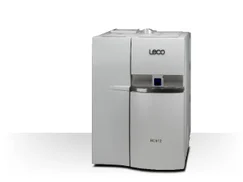Carbon is an essential building block of life on our planet. The amount of carbon present is an important factor in soils and agriculture. Carbon levels can help determine the quality of soil or the location of natural hydrocarbon fossil fuel deposits that may affect the quality of raw building materials. These levels can be determined by a Total Organic Carbon (TOC) determination. LECO’s line of instruments includes several that can determine TOC in different ways.
The most common method for determining TOC is the acid digestion method. By acid treating a sample, usually with something like hydrochloric acid, which is strong enough to react with inorganic carbonate
A resistance furnace acid such as LECO’s C832 can be used to analyze these samples for their carbon content. The C832 uses a pure oxygen environment to oxidize the samples, converting the carbon to CO2 gas. The CO2 is swept through the instrument’s reagents and carried to a non-dispersive infrared (NDIR) detection cell, where the infrared absorbance of CO2 is measured and converted to a carbon concentration based on the initial sample mass.
Another carbon determination method is temperature dependent. With the temperature dependent method, samples do not need to be pretreated. Organic carbon combusts to CO2 between 150°C and 450°C, while inorganic species combust below 1,000°C. The RC612 resistance furnace multiphase carbon and moisture determinator performs this analysis by using a two-step temperature ramping at 450°C and
1,000°C without any acid pretreatment of the samples. Similar to the C832, the CO2 gases are swept through to an NDIR at 450°C and again at 1,000°C to determine the TOC and TIC in the sample.
While both produce similar results, the RC612 has a longer runtime of approximately an hour, compared to the C832’s 90-second runtime. However, the C832 requires sample pretreatm
ent that can take multiple hours. The RC612 is better for low-throughput labs, while the pretreatment for the C832 can be done in large batches which can then be run through the instrument quickly, making it ideal for a high-throughput lab situation.
For a deeper look at how these two methods work and compare with LECO instruments, and the advancements in sample introduction methods, listen to Jeffery Gast, LECO’s lead analytical chemist, in an on-demand webinar.






